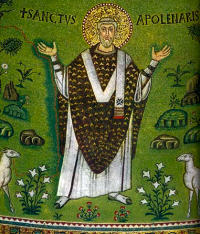Ordinary Time: July 20th
Optional Memorial of St. Apollinaris, bishop and martyr
Other Commemorations: St. Margaret of Antioch, Virgin and Martyr (RM); Elijah (Elias) the Prophet (RM); St. Frumentius, Bishop (RM)
» Enjoy our Liturgical Seasons series of e-books!
Early accounts report that Saint Apollinaris was ordained Bishop by Saint Peter himself and sent as a missionary bishop to Ravenna during the reign of the emperor Claudius. Renowned for his powers to heal in the name of Christ, he was frequently exiled, tortured and imprisoned for the faith, and finally martyred.
This optional memorial is new to the USA liturgical calendar and will be inscribed on July 20. It was dropped from the General Roman Calendar in 1968, at that time this feast was celebrated on July 23. This was the feast of St. Jerome Emiliani whose optional memorial is now celebrated on February 8. Today was also the commemoration of St. Margaret of Antioch, probably a virgin martyr of the third century. Her veneration spread from the East to the West at the time of the crusades. She is one of the Fourteen Holy Helpers.
Elias the Prophet's feast is celebrated today by the Eastern Church. He is revered as the spiritual Father and traditional founder of the Catholic religious Order of Carmelites. In addition to taking their name from Mt. Carmel where the first hermits of the order established themselves, the Calced Carmelite and Discalced Carmelite traditions pertaining to Elijah focus upon the prophet’s withdrawal from public life.[33][34] The medieval Carmelite Book of the First Monks offers some insight into the heart of the Orders' contemplative vocation and reverence for the prophet.
St. Apollinaris
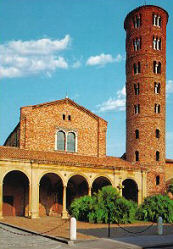 Apollinaris came to Rome from Antioch with the prince of the apostles, by whom he was consecrated bishop, and sent to Ravenna to preach the Gospel of our Lord Jesus Christ. He converted many to the faith of Christ, for which reason he was seized by the priests of the idols and severely beaten. At his prayer, a nobleman named Boniface, who had long been dumb, recovered the power of speech, and his daughter was delivered from an unclean spirit; on this account a fresh sedition was raised against Apollinaris. He was beaten with rods, and made to walk barefoot over burning coals; but as the fire did him no injury, he was driven from the city.
Apollinaris came to Rome from Antioch with the prince of the apostles, by whom he was consecrated bishop, and sent to Ravenna to preach the Gospel of our Lord Jesus Christ. He converted many to the faith of Christ, for which reason he was seized by the priests of the idols and severely beaten. At his prayer, a nobleman named Boniface, who had long been dumb, recovered the power of speech, and his daughter was delivered from an unclean spirit; on this account a fresh sedition was raised against Apollinaris. He was beaten with rods, and made to walk barefoot over burning coals; but as the fire did him no injury, he was driven from the city.
He lay hidden sometime in the house of certain Christians, and then went to Aemilia. Here he raised from the dead the daughter of Rufinus, a patrician, whose whole family thereupon believed in Jesus Christ. The prefect was greatly angered by this conversion, and sending for Apollinaris he sternly commanded him to give over propagating the faith of Christ in the city. But as Apollinaris paid no attention to his commands, he was tortured on the rack, boiling water was poured upon his wounds, and his mouth was bruised and broken with a stone; finally, he was loaded with irons, and shut up in prison. Four days afterward he was put on board ship and sent into exile; but the boat was wrecked, and Apollinaris arrived in Mysia, whence he passed to the banks of the Danube and into Thrace.
In the temple of Serapis the demon refused to utter his oracles so long as the disciple of the apostle Peter remained there. A search was made for some time, and then Apollinaris was discovered and commanded to depart by sea. Thus he returned to Ravenna; but on the accusation of the same priests of the idols, he was placed in the custody of a centurion. As this man, however, worshipped Christ in secret, Apollinaris was allowed to escape by night. When this became known, he was pursued and overtaken by the guards, who loaded him with blows and left him, as they thought, dead. He was carried away by the Christians, and seven days after, while exhorting them to constancy in the faith, he passed away from this life, to be crowned with the glory of martyrdom. His body was buried near the city walls.
—Excerpted from Roman Martyrology
Patronage: against epilepsy; against gout; archdiocese of Ravenna-Cervia, Italy; See CatholicSaints.info for a full list of regions.
Symbols and Representation: White vestments and black cross; club; hot coals; raven; crown; stones; cauldron of boiling water; chains; sword.
Often Portrayed As: Bishop with a club; standing or seated on hot coals; bearded, in a chasuble and pallium, with sheep around him; preaching to sheep.
Highlights and Things to Do:
- The Basilica of St. Apollinaris is considered the cradle of the Christian Faith in Italy and preserves the body of St. Apollinaris. Read Pope John Paul II's message on the 1,450th anniversary of the dedication of the Basilica.
- View some of the beautiful mosaics in the Basilicas of St. Apollinaris and St. Vitalis (German site—click on the main graphic, you don't have to speak German to enjoy the beautiful pictures!) and also this site on Ravenna Mosaics which includes some history.
- This link gives a little information about Byzantine Italy.
- Read the historical background on how Ravenna, Italy ended up with the glories of Byzantium in its Basilicas.
- Read what the Catholic Encyclopedia says about Ravenna.
- Learn more about St. Apollinaris:
- St. Apollinaris' body lies in The Basilica of Sant' Apollinare in Classe ("Saint Apollinaris in Classe") in Classe, Ravenna, Italy.
St. Margaret of Antioch, Virgin and Martyr
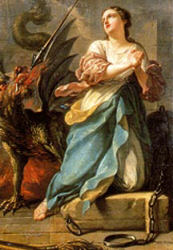 St. Margaret's feast has been suppressed because there is not much historical information about her life. There was great devotion to this saint, especially during the Middle Ages. She is one of the Fourteen Holy Helpers and one of the saints that appeared and spoke to St. Joan of Arc.
St. Margaret's feast has been suppressed because there is not much historical information about her life. There was great devotion to this saint, especially during the Middle Ages. She is one of the Fourteen Holy Helpers and one of the saints that appeared and spoke to St. Joan of Arc.
"This same day brings before us a rival of the warrior-martyr, St. George: Margaret, like him victorious over the dragon, and like him called in the Menaea of the Greeks, the Great Martyr. The cross was her weapon; and, like the soldier, the virgin, too, consummated her trial in her blood. They were equally renowned in those chivalrous times when valor and faith fought hand in hand for Christ beneath the standard of the saints. So early as the seventh century our Western island rivaled the East in honoring the pearl drawn from the abyss of infidelity. Before the disastrous schism brought about by Henry VIII, the Island of Saints celebrated this feast as a double of the second class; women alone were obliged to rest from servile work, in gratitude for the protection afforded them by St. Margaret at the moment of childbirth—a favor which ranked her among the saints called in the Middle Ages auxiliaries or helpers. But it was not in England alone that Margaret was invoked, as history proves by the many and illustrious persons of all countries who have borne her blessed name."
—Excerpted from The Liturgical Year, Abbot Gueranger O.S.B.
Patronage: against sterility; childbirth; dying; escape from devils; exiles; expectant mothers; falsely accused people; kidney disease; loss of milk by nursing mothers; Lowestoft, Suffolk, England; martyrs; nurses; peasants; people in exile; Queens College Cambridge; women; women in labour.
Symbols and Representation: Chained dragon; dragon burst asunder; girdle; sheep; garland of pearls; daisy; wreath of marguerites; long cross; crown.
Often Portrayed As: shepherdess; woman carrying a small cross in her hand; woman carrying a small girdle in her hand; woman leading a chained dragon; woman standing next to a cauldron or large vessel; woman standing with, on, or beside a dead dragon.
Highlights and Things to Do:
- Read more about St. Margaret of Antioch:
- See Saint Margaret of Antioch: The Iconography for some images of St. Margaret.
Holy Prophet Elias/Elijah
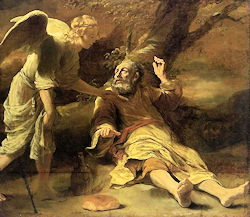 The prophet Elijah (Elias in Latin) appears in Scriptures (the Books of the Kings) as a man of God who lived always in God's presence and fought zealously for the worship of the one true God.
On Mount Carmel Elijah defended God's law in the solemn contest against the prophets of the false god Baal, and afterwards was given on Mount Horeb an intimate experience of the living God in 'the sound of sheer silence'. As a man of both prayer and service, he inspires Carmelites in their contemplative vocation. As a passionate defender of the truth, he gives particular inspiration to the Carmelites' work for justice, peace, and the integrity of Creation.
The prophet Elijah (Elias in Latin) appears in Scriptures (the Books of the Kings) as a man of God who lived always in God's presence and fought zealously for the worship of the one true God.
On Mount Carmel Elijah defended God's law in the solemn contest against the prophets of the false god Baal, and afterwards was given on Mount Horeb an intimate experience of the living God in 'the sound of sheer silence'. As a man of both prayer and service, he inspires Carmelites in their contemplative vocation. As a passionate defender of the truth, he gives particular inspiration to the Carmelites' work for justice, peace, and the integrity of Creation.
The first Carmelite hermits gathered by the 'Well of Elijah' on Mount Carmel, and regarded themselves as the 'sons of the prophet'. Although Carmelites no longer claims Elijah as literal 'founder' of our Order, the inspiration that was found in Elijah from the very beginnings of the Order so pervades its whole history that the prophet may deservedly be called the founder of the Carmelite ideal, the Father of All Carmelites, and Patron of the Carmelite Order.
Carmelites are unique in the Roman Catholic Church in the level of devotion that they give to such a figure of the Old or First Testament. Since Elijah is revered by Jews, Christians and Muslims, he is a figure that encourages Carmelites to engage in interfaith encounter and dialogue.
—Excerpted from Carmelite.org
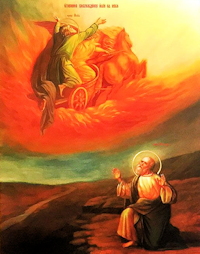 The life of the holy Prophet Elias/Elijah is recorded in the Old Testament books (3 Kings; 4 Kings; Sirach/Ecclesiastes 48: 1-15; 1 Maccabees 2: 58). At the time of the Transfiguration, the Prophet Elias/Elijah conversed with the Savior upon Mount Thabor (Tabor) (Mt. 17: 3; Mk. 9: 4; Lk. 9: 30).
The life of the holy Prophet Elias/Elijah is recorded in the Old Testament books (3 Kings; 4 Kings; Sirach/Ecclesiastes 48: 1-15; 1 Maccabees 2: 58). At the time of the Transfiguration, the Prophet Elias/Elijah conversed with the Savior upon Mount Thabor (Tabor) (Mt. 17: 3; Mk. 9: 4; Lk. 9: 30).
The iconographic tradition portrays the Prophet Elias rising up on a chariot with fiery wheels, which are encircled on all sides with flames and harnessed to four winged horses.
—Excerpted from Holy Trinity Orthodox
Patronage: Carmelite Order; vehicle blessings; Air Forces; civil aeronautics; Romanian Air Force
Highlights and Things to Do:
- Elijah the Prophet is an important saint to the Carmelite Order. At different times in its history the Carmelite Order has looked to one or more aspects of the prophet’s life: he is active and contemplative; one who heard and spoke the word of God; a friend of the dispossessed. Read more about St. Elijah and his Carmelite connection: Carmelites and Carmelite Sisters.
- Read St. Elijah, Spiritual Father of the Carmelite Order.
- Visit New Liturgical Movement about an Elijah mosaic.
- See the founder's statue in St. Peter's Basilica.
St. Frumentius
Edesius and Frumentius, brothers from Tyre, Phoenician, introduced Christianity into Abyssinia; the latter a saint and first Bishop of Axum is styled the Apostle of Abyssinia, d. about 383.
When still mere boys they accompanied their uncle Metropius on a voyage to Abyssinia. When their ship stopped at one of the harbor of the Red Sea, people of the neighborhood massacred the whole crew, with the exception of Edesius and Frumentius, who were taken as slaves to the King of Axum. This occurred about 316. The two boys soon gained the favor of the king, who raised them to positions of trust and shortly before his death gave them their liberty.
The widowed queen, however, prevailed upon them to remain at the court and assist her in the education of the young prince Erazanes and in the administration of the kingdom during the prince's minority. They remained and (especially Frumentius) used their influence to spread Christianity. First they encouraged the Christian merchants, who were temporarily in the country, to practice their faith openly by meeting at places of public worship; later they also converted some of the natives.
When the prince came of age, Edesius returned to his friends and relatives at Tyre and was ordained priest, but did not return to Abyssinia. Frumentius, on the other hand, who was eager for the conversion of Abyssinia, accompanied Edesius as far as Alexandria, where he requested St. Athanasius to send a bishop and some priests to Abyssinia. St. Athanasius considered Frumentius himself the most suitable person for bishop and consecrated him in 328, according to others between 340-46.
Frumentius returned to Abyssinia, erected his episcopal see at Axum, baptized King Aeizanas, who had meanwhile succeeded to the throne, built many churches, and spread the Christian Faith throughout Abyssinia. The people called him Abuna (Our Father) or Abba Salama (Father of Peace), titles still given to the head of the Abyssinian Church.
In 365 Emperor Constantius addressed a letter to King Aeizanas and his brother Saizanas in which he vainly requested them to substitute the Arian bishop Theophilus for Frumentius (Athanasius, "Apol. ad Constantium" in P.G., XXV, 631).
The Latins celebrate the feast of Frumentius on 27 October, the Greeks on 30 November, and the Copts on 18 December.
Abyssinian tradition credits him with the first Ethiopian translation of the New Testament.
—Excerpted from the Catholic Encyclopedia
Patronage: Abyssinia; Ethiopia
Highlights and Things to Do:
- Read about The Mysterious Rock Hewed Churches Of Lalibela built in the 12th century, each from one rock.
- Read more about St. Frumentius:


